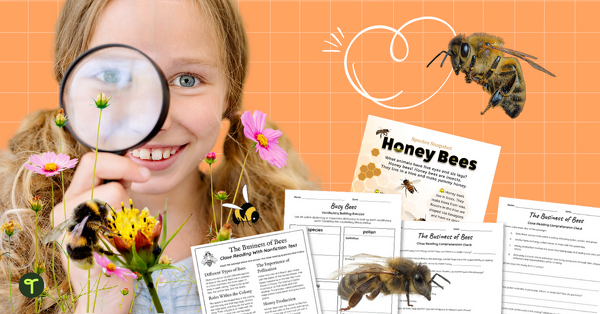While we may not be able to live on Mars (yet!), there’s a goldmine of interesting facts about Mars to enrich your primary students’ knowledge of the red planet and the galaxy around us. Mars is one of the most intriguing planets in the galaxy due to its shared similarities to Earth and ongoing mysteries … is there life on Mars?
To dig a little deeper, the Teach Starter teacher team has developed a list of fascinating facts about Mars and found answers to common questions such as, ‘Is there water on Mars?’ and ‘How many moons does Mars have?’ We’ve found the most fun facts to hook your students for a lesson on the planets or the solar system, as well as great discussion starters for morning meetings.
Keep reading for 20 kid-friendly facts about Mars, plus a few creative ways you can use these facts for classroom activities.
Interesting Facts About Mars for Kids
1. Mars is also known as the red planet, and you might have guessed why…because it’s red! Mars looks this way due to the abundance of a chemical compound called iron oxide in minerals and rocks, giving a rusty appearance.
2. When looking at a solar system diagram, you’ll see that Mars is actually pretty tiny — it’s the second smallest planet after Mercury.
3. So, how big is Mars compared to Earth? The Red Planet has a diameter of approximately 6780 km, making it around half the size of Earth.
4. You can sometimes spot Mars from Earth! As the two planets orbit around the Sun, Mars becomes more visible from here on Earth. Mars will be harder to spot at different orbit stages, and a telescope is the best way to catch a glimpse. So, next time you look up at the sky, keep an eye out for the bright red planet.
5. Did you know? Mars has two moons! They are called Phobos and Deimos and are believed to be two asteroids captured by Mars’ gravity when the solar system was formed.
6. Looking at Mars, you might guess by its reddish colour that it would have a hot climate, but the temperatures vary immensely and are often freezing! On average, it’s around -65°C on the planet, with temperatures reaching 21°C during summer and plummeting to -153° closer to the Poles. This is because Mars is farther from the sun than Earth, and its atmosphere is about 100 times thinner than Earth’s, meaning it can’t retain heat energy.
7. The ancient Romans named the planet after their god of war due to its red colour. The Egyptians also called the planet after its fiery hues, referring to Mars as ‘Her Desher,’ meaning ‘the red one.’
8. Ever wondered, ‘How long does it take to get to Mars?’ So have we! On average, it would take around seven months to reach Mars from Earth if travelling at almost 40000 km/h. That’s quite the journey!
9. Although Mars can be spotted from Earth, it is actually about 225 million km away.
10. Mars is believed to have been formed about 4.6 billion years ago from a large spinning disk of gas and dust.
11. NASA is using robots to explore Mars! To date, five robotic vehicles called ‘rovers’ have been sent to Mars and are used to explore the landscape, take photos and collect data for scientists to study.
12. Mars has seasons, extinct volcanoes, canyons, polar ice caps and changing weather like Earth.
13. The average day on Mars is 24 hours and 36 minutes — not much longer than here on Earth. However, a year on Mars is equal to 678 Earth days! This is because Mars takes much longer to complete its orbit around the Sun.
14. The largest canyon on Mars is called Valles Marineris, which stretches more than 4800 km. That’s 11 times as long as the Grand Canyon in the United States!
15. There is, in fact, water on Mars. It can be found as icy dirt below the surface in the Polar regions and traces of salty liquid water on hillsides. Historically, there are signs of river networks and lakes and deltas and indications of massive floods around 3.5 billion years ago.
16. It can get so windy on Mars that dust storms can cover most of the planet! These winds are so strong that it can take months for the dust to settle.
17. Did you know? Mars is home to the largest volcano in the solar system. It’s called Olympus Mons and stands a whopping 24 km high – three times taller than Mt. Everest. Whoa!
18. Mars is around 240 million km from the Sun, so it takes sunlight 13 minutes to reach Mars.
19. There’s around 60 percent less gravity on Mars than on Earth. So, trying to walk on Mars would be a very bouncy experience!
20. Want to visit Mars? It might be possible one day. There are plans to send astronauts to Mars in 2030, which will be the farthest humans have travelled from Earth since the Apollo 17 mission to the moon.
Ways to Use These Facts in The Classroom
- Mars Survival Simulation. Split your class into small groups and task them with creating a survival kit for living on Mars. Using the list of facts as a base, students can decide what they’ll need specific to the planet; for example, a spacesuit to protect against the harsh cold and materials to build shelter from dust storms. Students can present their essentials in poster format to share with the rest of the class, giving justification for each item based on their knowledge of Mars.
- Write a Short Story. Encourage students to choose a fact from the list about Mars and use it as a story starter! Students could use their imaginations to write about the adventures of a Mars rover or what the future might be like living on Mars.
- Compare and Contrast Task. Test your students’ knowledge of Mars and the Earth using a Venn Diagram template to weigh the similarities and differences between the two planets. For example, Mars and Earth experience seasons and have landmarks such as canyons and volcanoes, yet Earth has much more gravity and breathable air.











Comments